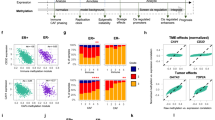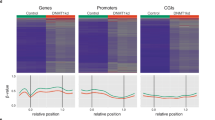Abstract
Extensive changes in DNA methylation are common in cancer and may contribute to oncogenesis through transcriptional silencing of tumor-suppressor genes1. Genome-scale studies have yielded important insights into these changes2,3,4,5 but have focused on CpG islands or gene promoters. We used whole-genome bisulfite sequencing (bisulfite-seq) to comprehensively profile a primary human colorectal tumor and adjacent normal colon tissue at single-basepair resolution. Regions of focal hypermethylation in the tumor were located primarily at CpG islands and were concentrated within regions of long-range (>100 kb) hypomethylation. These hypomethylated domains covered nearly half of the genome and coincided with late replication and attachment to the nuclear lamina in human cell lines. We confirmed the confluence of hypermethylation and hypomethylation within these domains in 25 diverse colorectal tumors and matched adjacent tissue. We propose that widespread DNA methylation changes in cancer are linked to silencing programs orchestrated by the three-dimensional organization of chromatin within the nucleus.
This is a preview of subscription content, access via your institution
Access options
Subscribe to this journal
Receive 12 print issues and online access
$209.00 per year
only $17.42 per issue
Buy this article
- Purchase on Springer Link
- Instant access to full article PDF
Prices may be subject to local taxes which are calculated during checkout






Similar content being viewed by others
References
Jones, P.A. & Baylin, S.B. The fundamental role of epigenetic events in cancer. Nat. Rev. Genet. 3, 415–428 (2002).
Gal-Yam, E.N. et al. Frequent switching of Polycomb repressive marks and DNA hypermethylation in the PC3 prostate cancer cell line. Proc. Natl. Acad. Sci. USA 105, 12979–12984 (2008).
Irizarry, R.A. et al. The human colon cancer methylome shows similar hypo- and hypermethylation at conserved tissue-specific CpG island shores. Nat. Genet. 41, 178–186 (2009).
Gebhard, C. et al. General transcription factor binding at CpG islands in normal cells correlates with resistance to de novo DNA methylation in cancer cells. Cancer Res. 70, 1398–1407 (2010).
Noushmehr, H. et al. Identification of a CpG island methylator phenotype that defines a distinct subgroup of glioma. Cancer Cell 17, 510–522 (2010).
Hinoue, T. et al. Genome-scale analysis of aberrant DNA methylation in colorectal cancer. Genome Res. published online, doi:10.1101/gr.117523.110 (9 June 2011).
Lister, R. et al. Human DNA methylomes at base resolution show widespread epigenomic differences. Nature 462, 315–322 (2009).
Lister, R. et al. Hotspots of aberrant epigenomic reprogramming in human induced pluripotent stem cells. Nature 471, 68–73 (2011).
ENCODE Project Consortium. et al. User's guide to the encyclopedia of DNA elements (ENCODE). PLoS Biol. 9, e1001046 (2011).
Irizarry, R.A., Wu, H. & Feinberg, A.P. A species-generalized probabilistic model-based definition of CpG islands. Mamm. Genome 20, 674–680 (2009).
Widschwendter, M. et al. Epigenetic stem cell signature in cancer. Nat. Genet. 39, 157–158 (2007).
Schlesinger, Y. et al. Polycomb-mediated methylation on Lys27 of histone H3 pre-marks genes for de novo methylation in cancer. Nat. Genet. 39, 232–236 (2007).
Ohm, J.E. et al. A stem cell–like chromatin pattern may predispose tumor suppressor genes to DNA hypermethylation and heritable silencing. Nat. Genet. 39, 237–242 (2007).
Visel, A. et al. ChIP-seq accurately predicts tissue-specific activity of enhancers. Nature 457, 854–858 (2009).
Rada-Iglesias, A. et al. A unique chromatin signature uncovers early developmental enhancers in humans. Nature 470, 279–283 (2011).
Boumber, Y.A. et al. An Sp1/Sp3 binding polymorphism confers methylation protection. PLoS Genet. 4, e1000162 (2008).
Cuddapah, S. et al. Global analysis of the insulator binding protein CTCF in chromatin barrier regions reveals demarcation of active and repressive domains. Genome Res. 19, 24–32 (2009).
Estécio, M.R. et al. Genome architecture marked by retrotransposons modulates predisposition to DNA methylation in cancer. Genome Res. 20, 1369–1382 (2010).
Heinz, S. et al. Simple combinations of lineage-determining transcription factors prime cis-regulatory elements required for macrophage and B cell identities. Mol. Cell 38, 576–589 (2010).
Aguilera, C. et al. c-Jun N-terminal phosphorylation antagonises recruitment of the Mbd3/NuRD repressor complex. Nature 469, 231–235 (2011).
Jones, P.A. The DNA methylation paradox. Trends Genet. 15, 34–37 (1999).
Hellman, A. & Chess, A. Gene body-specific methylation on the active X chromosome. Science 315, 1141–1143 (2007).
Frigola, J. et al. Epigenetic remodeling in colorectal cancer results in coordinate gene suppression across an entire chromosome band. Nat. Genet. 38, 540–549 (2006).
Coolen, M.W. et al. Consolidation of the cancer genome into domains of repressive chromatin by long-range epigenetic silencing (LRES) reduces transcriptional plasticity. Nat. Cell Biol. 12, 235–246 (2010).
Guelen, L. et al. Domain organization of human chromosomes revealed by mapping of nuclear lamina interactions. Nature 453, 948–951 (2008).
Peric-Hupkes, D. et al. Molecular maps of the reorganization of genome-nuclear lamina interactions during differentiation. Mol. Cell 38, 603–613 (2010).
Chua, Y.L. et al. The NRG1 gene is frequently silenced by methylation in breast cancers and is a strong candidate for the 8p tumour suppressor gene. Oncogene 28, 4041–4052 (2009).
Dahl, E. et al. Frequent loss of SFRP1 expression in multiple human solid tumours: association with aberrant promoter methylation in renal cell carcinoma. Oncogene 26, 5680–5691 (2007).
Witcher, M. & Emerson, B.M. Epigenetic silencing of the p16(INK4a) tumor suppressor is associated with loss of CTCF binding and a chromatin boundary. Mol. Cell 34, 271–284 (2009).
Hawkins, R.D. et al. Distinct epigenomic landscapes of pluripotent and lineage-committed human cells. Cell Stem Cell 6, 479–491 (2010).
Heintzman, N.D. et al. Histone modifications at human enhancers reflect global cell-type-specific gene expression. Nature 459, 108–112 (2009).
Hansen, R.S. et al. Sequencing newly replicated DNA reveals widespread plasticity in human replication timing. Proc. Natl. Acad. Sci. USA 107, 139–144 (2010).
Aran, D., Toperoff, G., Rosenberg, M. & Hellman, A. Replication timing-related and gene body-specific methylation of active human genes. Hum. Mol. Genet. 20, 670–680 (2011).
Lieberman-Aiden, E. et al. Comprehensive mapping of long-range interactions reveals folding principles of the human genome. Science 326, 289–293 (2009).
Pickersgill, H. et al. Characterization of the Drosophila melanogaster genome at the nuclear lamina. Nat. Genet. 38, 1005–1014 (2006).
Xiang, Y. et al. JMJD3 is a histone H3K27 demethylase. Cell Res. 17, 850–857 (2007).
Li, H. et al. The Sequence Alignment/Map format and SAMtools. Bioinformatics 25, 2078–2079 (2009).
Sun, W. et al. Integrated study of copy number states and genotype calls using high-density SNP arrays. Nucleic Acids Res. 37, 5365–5377 (2009).
Balwierz, P.J. et al. Methods for analyzing deep sequencing expression data: constructing the human and mouse promoterome with deepCAGE data. Genome Biol. 10, R79 (2009).
Acknowledgements
We acknowledge generous support of the University of Southern California Epigenome Center by the Kenneth T. and Eileen L. Norris Foundation. We are grateful to S. Hansen for providing DNA replication data. High performance computing support was provided by the University of Southern California High Performance Computing Center (see URLs). We are greatly indebted to Denise Culhane for her superb proofreading skills.
Author information
Authors and Affiliations
Contributions
The project was conceived and the experiments were designed by P.W.L., D.J.W., B.P.B., D.V.D.B. and T.H. The Bisulfite-seq library construction and Genome Analyzer sequencing were performed by D.J.W., J.F.A. and D.V.D.B. The Infinium genotyping and data analysis was performed by B.P.B., motif analysis by H.N. and pipeline automation by B.P.B. and Z.R. Bisulfite-seq data processing and analysis were performed by B.P.B., Z.R. and H.N. Validation samples were collected and analyzed by C.P.E.L., C.M.v.D., R.A.E.M.T., B.P.B., D.J.W. and T.H. The manuscript was prepared by B.P.B. and P.W.L., and the study was supervised by P.W.L.
Corresponding author
Ethics declarations
Competing interests
P.W.L. is scientific advisory board member and consultant for Epigenomics, AG, which has a commercial interest in DNA methylation biomarkers. The work described in this manuscript was not supported by nor will it benefit Epigenomics, AG.
Supplementary information
Supplementary Text and Figures
Supplementary Note, Supplementary Figures 1–16 (PDF 45448 kb)
Supplementary Tables 1 and 2
Bisulfite-seq summary statistics and Bisulfite-seq detailed statistics by chromosome (XLSX 91 kb)
Rights and permissions
About this article
Cite this article
Berman, B., Weisenberger, D., Aman, J. et al. Regions of focal DNA hypermethylation and long-range hypomethylation in colorectal cancer coincide with nuclear lamina–associated domains. Nat Genet 44, 40–46 (2012). https://doi.org/10.1038/ng.969
Received:
Accepted:
Published:
Issue Date:
DOI: https://doi.org/10.1038/ng.969
This article is cited by
-
DNMT3B PWWP mutations cause hypermethylation of heterochromatin
EMBO Reports (2024)
-
Altered cfDNA fragmentation profile in hypomethylated regions as diagnostic markers in breast cancer
Epigenetics & Chromatin (2023)
-
Comprehensive analyses of partially methylated domains and differentially methylated regions in esophageal cancer reveal both cell-type- and cancer-specific epigenetic regulation
Genome Biology (2023)
-
Global effects of identity and aging on the human sperm methylome
Clinical Epigenetics (2023)
-
DMRscaler: a scale-aware method to identify regions of differential DNA methylation spanning basepair to multi-megabase features
BMC Bioinformatics (2022)



